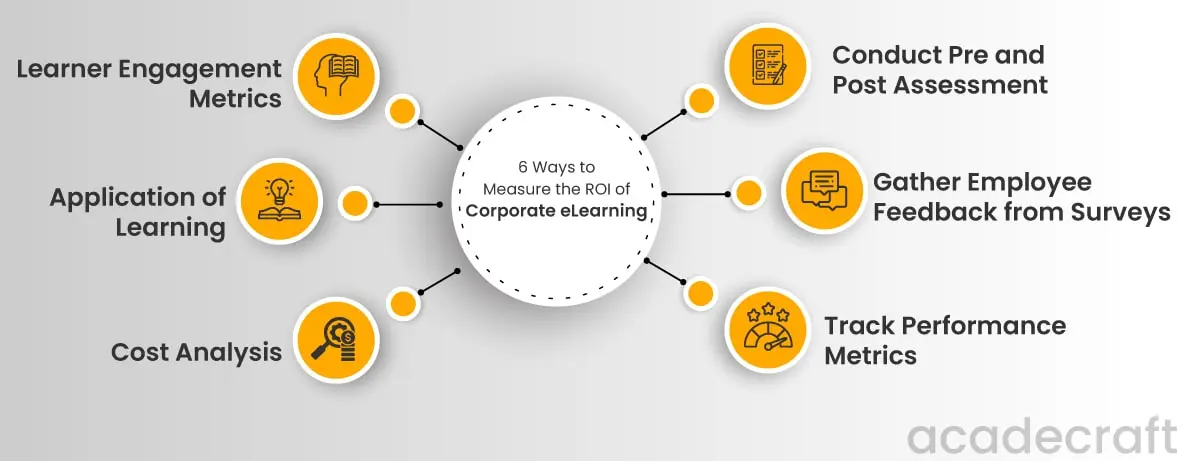
In this competitive business world, corporate eLearning has emerged as a powerful tool to equip employees with the knowledge and skills they need to thrive in their roles. However, measuring corporate eLearning initiatives' return on investment (ROI) can be complex.
In this blog, we will discuss how to measure the ROI of corporate eLearning. It is essential to have a systematic approach to measuring their effectiveness to ensure that these programs provide tangible value to the organization.
By evaluating the ROI, companies can make informed decisions about allocating resources and ensure that their eLearning programs deliver tangible benefits. Here are key ways to measure the ROI of corporate eLearning:

Conducting pre-and-post assessments is a fundamental method to measure the ROI of eLearning. By comparing the knowledge and skills of employees before and after the eLearning program, organizations can assess the learning outcomes and quantify the impact of the training.
Gathering employee feedback through surveys and interviews can provide valuable insights into the effectiveness of eLearning programs. Employees' perceptions of the training content, its relevance to their roles, and its impact on their performance can help organizations evaluate the ROI and identify areas for improvement.
For instance, if employees report that the content is difficult to understand, consider making changes and giving employees the option to retake the course. If the employees still struggle with the content, consider revising the training process or adding additional resources.
Tracking performance metrics allows companies to gauge the impact of eLearning on key performance indicators (KPIs). These metrics can include productivity levels, customer satisfaction scores, sales revenue, or other relevant metrics aligning with the organization's goals. By comparing the performance metrics of employees who have undergone eLearning with those who haven't, organizations can identify the direct impact of eLearning on performance.
One way to measure the ROI of corporate eLearning is by assessing learner engagement metrics. It includes tracking the number of employees participating in the eLearning courses, their completion rates, and the average time spent on each module. By analyzing these metrics, you can gauge the level of interest and commitment from your employees, which can indicate the effectiveness of the eLearning program.
Measuring the ROI of corporate eLearning also involves assessing how well employees apply what they have learned in their day-to-day work. It can be done through surveys, interviews, or observation of employee performance. By evaluating the practical application of the learned skills, you can determine the impact of the eLearning program on job performance and productivity.
It is necessary to conduct a cost analysis to determine the ROI of corporate e-learning. This includes assessing the expenses of developing and implementing the eLearning program, such as content creation, technology infrastructure, and employee training time.
By comparing these costs with the benefits derived from the program, you can calculate the return on investment. For instance, if an eLearning program costs $50,000 to develop and implement and results in a $70,000 increase in productivity, the return on investment would be 40%.
Also Read: Learning Objectives for Corporate eLearning: A Guide to Success.
The ROI helps measure the program's effectiveness and can determine whether it is worth continuing. It also helps to identify areas of improvement and ensure that future programs are more successful.
This metric has the advantage of being familiar to any financial or accounting expert and having credibility among executives. And that's a significant issue. For instance, when an executive asks for the ROI of a training program, the metric allows you to show how much revenue was generated for every dollar spent on the program.
Let's understand a few of these corporate training ROI metrics:
One of the primary metrics for determining the ROI of corporate training is the cost per trainee. This metric calculates the total expenses incurred in delivering training programs divided by the number of trainees. By comparing this cost against the benefits derived from the training, organizations can assess the cost-effectiveness of their training initiatives.
Measuring the training completion rates provides valuable insights into employees' engagement levels and commitment toward the training programs. This metric helps organizations identify any potential gaps in training effectiveness or barriers to completion, allowing them to take necessary actions to improve employee participation and overall training outcomes.
Evaluating employee performance before and after training is an effective way to gauge the impact of corporate training. Metrics such as employee productivity, sales performance, customer satisfaction ratings, or quality of work can provide tangible evidence of the training's effectiveness in enhancing employee skills and knowledge. You can do so by investing in custom eLearning content development. This way, you can ensure that your employee is given personalized training, and hence it will maximize their overall performance.
Assessing knowledge retention is crucial to determine if the training successfully transfers and embeds relevant employee knowledge and skills. Post-training assessments, quizzes, or practical evaluations can be used to measure retention levels and gauge the long-term impact of training on employee performance.
For instance, a post-training test can be conducted that measures the understanding of a particular concept or skill, and the results can be compared to a pre-training test to gain insights into the employees' knowledge retention.
Time to Competency measures employees' period to become proficient in applying newly acquired skills and knowledge. By tracking the time taken to reach competency levels, organizations can assess the efficiency of their training programs and identify any areas that require improvement to accelerate the learning process.
Employee engagement and satisfaction are essential factors in determining the success of corporate training initiatives. Surveys, feedback forms, or focus group discussions can be used to gather insights into employee perceptions of the training content, delivery methods, and overall training experience. Positive engagement and satisfaction levels indicate the effectiveness of the training in meeting employee needs and expectations.
Bonus Read: Why Corporate Learning Programs Need to Consider Context?
As you have now understood how to Measure the ROI of Corporate eLearning, it is essential to determine the effectiveness of training programs and ensure that companies get the most out of their investments.
By accurately assessing the impact of eLearning on the company, businesses can make intelligent decisions about the types of programs they invest in and optimize their training for maximum efficiency.
By tracking the key metrics, businesses can gain insight into which eLearning programs have the most significant impact on the company's bottom line. ROI can help businesses identify which eLearning programs are worth investing in and which programs can be improved or eliminated.
Investing in corporate elearning solutions can help businesses save money on travel and training costs and allow them to scale their training programs quickly and efficiently. We are here for you to make your dreams come true. Contact us to reach a greater height of success.
Share